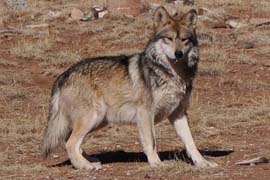Mexican gray wolf:
• Most genetically distinct subspecies of gray wolf in North America.
• Also known as "lobo."
• Reintroduced in Arizona and New Mexico in 1998 through the Mexican Gray Wolf Recovery Program.
• At last count, 75 were in the wild.
• Packs range from three to five wolves.
• Also known as "lobo."
• Reintroduced in Arizona and New Mexico in 1998 through the Mexican Gray Wolf Recovery Program.
• At last count, 75 were in the wild.
• Packs range from three to five wolves.
Representatives of Arizona conservation groups, which have raised concerns about the proposals, said they are grateful to have the opportunity to address the U.S. Fish and Wildlife Service.
“We’re pleased that there will be a hearing in Arizona because Arizona has a long history of supporting recovery of these animals,” said Sandy Bahr, director of the Sierra Club’s Grand Canyon Chapter.
Mexican gray wolves, which are native to Arizona, New Mexico, Texas and Mexico, were reintroduced to Arizona and New Mexico in 1998. Seventy-five wolves were accounted for at the end of 2012, up from 58 the previous year.
While many ranchers contend that the wolves conflict with their livestock, conservation groups argue that the recovery effort hasn’t done enough to promote genetic diversity and the survival of pups.
The Fish and Wildlife Service’s proposals, which were released in June, include declassifying gray wolves as an endangered species. Mexican gray wolves would retain protection as a separate endangered subspecies and nonessential experimental population.
The proposals would allow the release of captive wolves in New Mexico’s Gila National Forest – it’s currently allowed only in Arizona’s Apache National Forest – and expand the wolves’ recovery area throughout the two states.
Fish and Wildlife originally planned to hold formal public meetings in Sacramento, Calif., Washington, D.C., and Albuquerque, N.M., but added one in Arizona following the senators’ request. A date and location for the Arizona meeting has yet to be determined.
“It was unfortunate that the Fish and Wildlife Service repeatedly ignored the interests of Arizonans in its rulemakings, even though the state shoulders the largest burden of the Mexican wolf program,” Flake said in a news release.
The Arizona Game and Fish Department, which helps manage the wolves, held public meetings in Payson, Pinetop and Tucson in September.
“The comments were pretty consistent in that a lot of the livestock operators have concerns about the program,” Game and Fish spokeswoman Lynda Lambert said.
Bahr, with the Sierra Club, said she would like to see the Mexican gray wolf gain full endangered species protection.
“Experimental nonessential (animals) are harassed a lot more, tend to be killed and removed for a variety of reasons,” she said. “Because of that, we have not seen the population recover the way it should.”
Michael Robinson, conservation advocate with the Tucson-based Center for Biological Diversity, said the proposals pair damaging provisions, such as lowering the threshold for legally shooting a wolf and not connecting the expanded area with the Grand Canyon, with attempted solutions such as additional room for wolf releases.
“It shows the one-step-forward, two-steps-backward approach of the federal government in this policy at the moment,” he said.
Fish and Wildlife’s proposals remain in the public comment stage, which will most likely have to be extended past the Oct. 28 deadline in order to schedule and conduct the public hearings, said Tom Buckley, Albuquerque-based spokesman for the U.S. Fish and Wildlife Service.
source


No comments:
Post a Comment